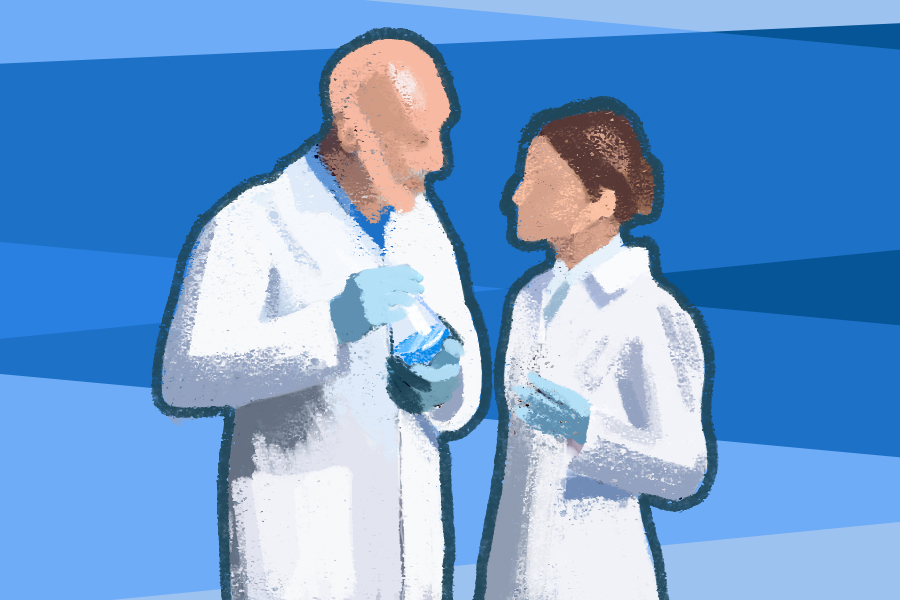
Storytelling, improvisation come together to help scientists engage with audience
Communication issues occur in day-to-day life, and a recent science communication workshop tackled these issues. Participants included faculty, students, staff from the Alan Alda Center for Communicating Science and, an actor known for his role on “M*A*S*H,” Alan Alda himself.
The primary focus of the workshop was to use storytelling and improv to improve the effectiveness of scientists’ communication with the public, who usually do not have the same level of expertise and knowledge that a researcher does.
“Most of the time, we think people know what we’re talking about,” said Kat Kerlin, an environmental sciences news and media relations specialist for the Office of Strategic Communications. “And a lot of the time they don’t. You have to be really careful about that when you’re trying to get across a message.”
The workshop lasted three days and featured a variety of activities, including recorded mock interviews, emotional storytelling and nonverbal mimicking.
“It might be my most amazing three days of work that I’ve spent,” said Carson Jeffres, the field and lab director of the UC Davis Center for Watershed Sciences. “A lot of it is based on improv, so a lot of the instructors are actors. If you’re telling a story, one of the ways that people remember your story is making some sort of emotional connection.”
Getting people to pay attention is the first step and keeping that interest with an emotional connection and story is the next. However, another hurdle is walking through the complexity of the research.
“The point isn’t to dumb it down, it’s to simplify it,” Jeffres said. “When you have a simple message, it’s often clearer, and that’s really important. You don’t want to sound condescending by dumbing it down, but you do need to simplify it because we do speak a different language, even amongst the scientists. […] People will listen if you’re interested and excited about the subject as well, so being able to convey your enthusiasm along with an understandable vernacular will help tell that story.”
Kerlin added that stripping out scientific jargon and explaining research through straightforward and relatable metaphors are some of the most helpful ways to simplify the information. Continuously talking to people who have limited knowledge of the research allows a scientist to practice their explanations. Sharing pictures of the work or the researcher in the field also keeps people interested.
Actively seeking ways to help citizens understand science and helping them learn to trust the researcher’s work is one of the driving forces for Ann Willis, a Ph.D. student in the department of environmental and civil engineering. Willis created a program called Scientists for Public Engagement and Knowledge, which focuses on expanding scientists’ toolkits in expressing their work to the public in an engaging way.
“It was the morning that the news headlines were about President Trump pulling the United States out of the Paris Accords,” Willis said. “I just thought, enough. We can no longer sit on the sidelines. Scientists can no longer feel insecure about talking about what we do and what we say, because what we do is critically important. It literally saves people’s lives, and decisions like that will endanger people. We have a responsibility as professionals.”
Some UC Davis researchers have noted that because of their academic style of speaking, citizens see them as more cold and robotic rather than another human being who has interests and passions. One of the main points of the workshop was to remind scientists how important a personal connection is to the citizen.
“So much of [the workshop] wasn’t about, ‘how do you message your science,’ [but] it was just, ‘how do you connect with another human being, period’,” Willis said. “First look them in the eye, then mirror their gesture, and tell them a story that’s just a story. You know you can do this since you’ve done it all your life, and now you just have to remember how to bring the humanity back into the science and humanities. That was not a big part of any classroom training I’ve ever had. When you present at conferences, that’s definitely not the model that’s presented for new and developing scientists, so part of it, I think, is that we’re just inheriting this tradition of bad communication habits, and there aren’t better models out there.”
As a self-proclaimed lover of the environment and environmental sciences, Kerlin said she wasn’t sure what to expect taking up a journalism job as someone who didn’t directly study what she had to report on. However, she stated that her lack of knowledge in these situations actually helped her, as she could ask questions that citizens may have had and quell those fears or clear up confusion.
“I didn’t realize how much I didn’t trust scientists until I sat with them and heard about their kids and lives,” Kerlin said. “I learned about them as fuller people and saw the work that they do and was so impressed by it that I came to trust them. Most people don’t get to do that. So it’s my job to at least relay some of that to others and hopefully put across some of that trust.”
Written by: Jack Concordia — science@theaggie.org




